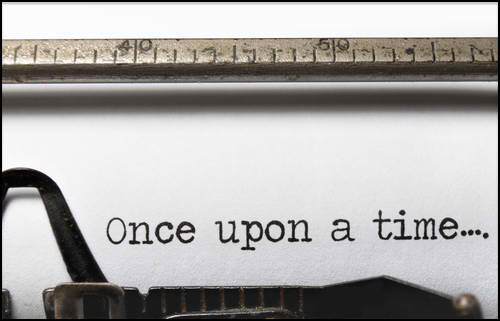Stories matter. Not just in marketing, but in real life. Think about your own life: last time you caught up with your best friend over a creamy latte, what did you do? Did you stare in silence into the foamy milk? Highly unlikely. Did you provide a polished run-down of the events of your life since your last meeting, complete with PowerPoint slides and hand-outs? Doubtful.
You told stories. You regaled your buddy with amusing tales; the antics of your husband / wife / partner / children / dog, the crazy meeting with your creepy boss, plans for your next overseas sojourn / house renovations / wedding plans.
We all tell stories, everyday. Why? Because stories make people feel. Stories garner an emotional, primal response: sympathy, empathy, joy, despair. These emotional responses create a powerful bond between the storyteller and their audience.
This should come as no surprise then: brand storytelling is a powerful medium for the creation of customer loyalty, and the bolstering of brand equity. Effective brand storytelling should elicit a primal, emotional response, similar to that provoked by your best friend over a latte.
When it comes to brand storytelling, one of the most powerful types of brand story that you can tell is your Genesis Story. People naturally want to be part of something bigger than themselves. A faceless, soulless corporation that has no discernable story, no values, no purpose, no vision, is not inspiring. A corporation with nothing to say, other than buy my products does not inspire customer loyalty, shareholder investment, or employee engagement.
The Genesis Story
According to Fortune Magazine, “genesis stories illuminate the motivation behind the brand or the company at its founding”. They clarify how a business responds to real customer desires. They demonstrate value add. They dramatize product benefits and features, eliciting a real, deep-seated connection between customers and products. In telling your genesis story, you give your audience an insight into the foundational beliefs that drive your company’s values.
The Unilever Genesis Story
UK based Unilever has a powerful genesis story. With a history reaching back to the 1890s, Unilever is one of the oldest multi-national companies, and the third largest consumer goods company in the world (as measured by revenue).
In the 1890s, William Hesketh Lever, set about the invention and introduction of a brand new, revolutionary product: Sunlight Soap. In a time when half of all babies in England did not see their first birthday, Lever wanted to make cleanliness commonplace. He wanted to foster health and hygiene, and to lessen the workload for women. He set out to make life more enjoyable for his customers. But he didn’t stop there. According to the Unilever genesis story, Lever continually pondered how he could grow his business so that more people could benefit, so that more babies could survive, so that health and hygiene would become commonplace.
Fast-forward more than 120 years, and these values still influence the day-to-day operations of Unilever. Today, Unilever CEO Paul Polman is facing the same issues, and applying the same values. According to Polman, the only difference is that today, “the issues have just moved to sub-Saharan Africa and India”, where another of William Lever’s inventions, Lifebuoy Soap, is on-hand to help improve health, hygiene and cleanliness.
The Spanx Genesis Story
It was 1998. A pair of white pants hung in Sara Blakely’s wardrobe, unworn. Sara was desperately frustrated. She wanted to wear her white pants but, no matter what she tried, Sara simply could not find the right undergarment to match her white pants. So, Sara took matters into her own hands. She researched hosiery, wrote her own design patent, and found a mill crazy enough to produce her pantyhose. She perfected her pantyhose prototype.
The problem was, she had no buyers. Not one to be discouraged, Sara phoned the buyer at Neiman Marcus. Sara promised that if she could have just ten minutes of her time, she would fly directly to Dallas and demonstrate a product that their customers simply could not live without. Demonstrate she did. Sara took the Neiman Marcus buyer into the change rooms, giving her a real, live ‘before’ and ‘after’ in her white pants. Three weeks later, Spanx were on the shelves in Neiman Marcus. Sara pulled the same stunt in Saks, in Nordstrom, in Bloomingdales. “I wore those white pants for three years to sell Spanx,” Blakely says. The story of the white pants has become a key driver of the $250 million Spanx brand.
The Boost Juice Genesis Story
Boost Juice does the genesis story extremely well. They even start the ‘About Us’ page on their website with the words ‘once upon a time’. Immediately, readers are invited to empathise with Boost Juice founder, Janine Allis. She admits that she was not an experienced retailer at the outset; she was just a girl from the burbs who wanted to be more in control of her own destiny. Back in 1999, Janine and her husband visited the US and experienced the juice and smoothie boom firsthand. With little more than a blank piece of paper, and the faith of a few early investors, Boost Juice was born.
Janine’s husband, Jeff, found a storefront in Adelaide, and nominated his father as scout. Jeff’s dad sat out the front of the premises counting foot-traffic, gender, age, and a range of other demographics before they signed on the dotted line. Then, Janine worked in the first store, day in, day out. She scrubbed floors and blenders, chopped fruit, and served customers. She made sure she knew the business inside outside. She personally built the brand, one customer at a time. She listened to customer feedback, always. And, 11 years on, the customer still comes first. As a result, Boost now has over 300 stores in more than 11 countries worldwide.
The Lorna Jane Genesis Story
Australian fashion designer, author, and entrepreneur, Lorna Jane Clarkson is a businesswoman who knows how to tell a brand story. Her story begins more than 25 years ago. Frustrated by the boring, uninspired range of activewear available for women, she started sewing her own outfits to wear while she was working as a fitness instructor in Brisbane. Her designs quickly gained a following, with her students placing order upon order. Soon, she couldn’t keep up with demand. Lorna Jane quit her day job as a dental therapist and focused on designing full-time. She opened her first store in Brisbane in 1990. Today, she has more than 150 stores worldwide, even opening her first American branches in 2012.
To close, a word of warning: do not fabricate a genesis story where there is none to tell. eBay tried this tactic in the 1990s. An over-imaginative PR pro dreamed up a delightful little ditty about eBay founder Pierre Omidyar. Once upon a time, Omidyar’s fiancé had a vast array of Pez candy dispensers. But, she was distraught to discover that there was no easily accessible market on which to trade the plastic bundles of joy. Enter eBay: the answer to every collectors’ trading nightmare. The only problem was, this genesis story was a fairy tale, a fabrication, dreamed up to generate media coverage. Luckily for Omidyar, and the PR pro, the truth wasn’t revealed until years later, by which time eBay was highly successful and suffered no consequences. But, this may not be the case for everyone. In the increasingly transparent, online sphere, commentators and opponents can be merciless. Fabricating stories, and telling little white lies, is simply not worth the backlash.
Sources:
- http://fortune.com/2014/04/18/how-great-marketers-tell-stories/
- http://www.inc.com/magazine/201402/adam-bluestein/sara-blakely-how-i-got-started.html



